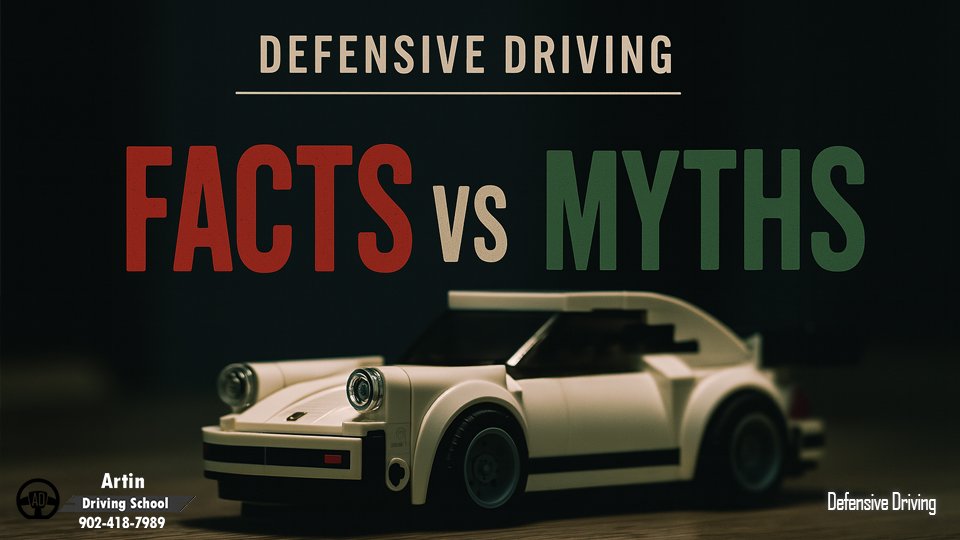Here in Nova Scotia, we take pride in being good drivers. But over time, it’s easy to pick up habits or beliefs that seem right but are actually common defensive driving myths. These misconceptions can give you a false sense of security, which is the last thing you want when navigating a busy roundabout in Halifax or a foggy stretch of highway on the way to Yarmouth.
True defensive driving isn’t just a buzzword; it’s a proactive mindset that saves lives. Let’s clear the air by debunking five common misconceptions and revealing what’s actually true about staying safe on the road.
On This Page:
1. The Myth of “Slower is Always Safer”
One of the most persistent beliefs is that defensive driving simply means driving slowly. The image is often someone going 10 km/h below the speed limit, believing they are the safest car on the road while a long line of traffic builds behind them.
The Truth: It’s About Driving to Conditions
The goal is to move smoothly with the flow of traffic while maintaining a safe space cushion. Driving significantly slower than other cars can be just as dangerous as speeding. It disrupts the harmony of the road and can cause impatient drivers to make risky passing maneuvers. A true defensive driver adjusts their speed based on traffic, weather, and visibility, whether that means going the speed limit or reducing speed for safety. It’s about being smart, not just slow.

2. The “It’s Just for Learners” Belief
Many experienced drivers believe that defensive driving courses and principles are for teenagers getting their first license. They feel that after decades on the road, their own experience is all the training they need to stay safe.
The Truth: Complacency Is the Enemy of Safety
Experience is valuable, but it can also lead to complacency. Over time, even the best drivers can develop risky habits without realizing it, like rolling stops or following too closely. Traffic patterns change and vehicle technology evolves. Professional defensive driving training helps experienced drivers unlearn bad habits and refresh their knowledge. This specific misconception is one of the more dangerous defensive driving myths because it discourages continuous learning.
3. The Myth of Constant Yielding
Another common idea is that being a defensive driver means you must always surrender the right-of-way to everyone else. This paints defensive driving as a completely passive and timid activity, which is not the case.
The Truth: It’s About Being Predictable, Not Passive
Defensive driving is about protecting yourself by anticipating others’ actions. While that sometimes means letting an aggressive driver go first to avoid a collision, the core principle is to be predictable. Hesitating when it’s your turn to go at a four-way stop can confuse other drivers and actually cause a crash. A defensive driver is clear, confident, and predictable, communicating their intentions and making it easier for others to anticipate their actions.
4. The “My Car Will Do It for Me” Fallacy
With features like Automatic Emergency Braking and Lane-Keeping Assist, it’s easy to believe your car is doing the defensive driving for you. Many people think this technology can replace driver attentiveness.
The Truth: Technology Assists, It Doesn’t Replace
Those safety systems are incredible, but they are driver *aids*, not driver replacements. As noted by safety experts like the Traffic Injury Research Foundation, human error is still a leading cause of crashes. Your technology has limits. It might not see a deer on a dark road or react correctly in a sudden snowstorm. Your brain is your primary safety system; these myths about driving technology can lead to a dangerous lack of focus.
5. The Overconfidence Trap
This is the ultimate myth that many drivers tell themselves: “I’m a good driver with a clean record, so I’m already driving defensively.” Most people rate themselves as above-average drivers, which is statistically impossible.
The Truth: Good Technique and Defensive Awareness Are Different
Being a “good driver” often means you have solid technical skills. Being a “defensive driver” is about a higher level of awareness. It’s the conscious practice of scanning ahead, managing space, predicting hazards, and planning escape routes. It’s an ongoing mental process, not a fixed state of being. Believing you have nothing left to learn is one of the most pervasive defensive driving myths out there. The best drivers know they can always improve.
Ready to move past the myths and learn the proven techniques that keep you safe? Take a certified course at Artin Driving School.
The information provided on this post is for general informational purposes only and is not intended to serve as professional advice or guidance. While Artin Driving School strives to ensure the accuracy and timeliness of the information shared, Artin Driving School makes no guarantees, warranties, or representations regarding the completeness, reliability, or suitability of any content posted.






I am glad to be one of several visitants on this outstanding website (:, regards for posting.